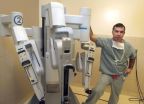(Press-News.org) PHILADELPHIA — Engineering structures on the smallest possible scales — using molecules and individual atoms as building blocks — is both physically and conceptually challenging. An interdisciplinary team of researchers at the University of Pennsylvania has now developed a method of computationally selecting the best of these blocks, drawing inspiration from the similar behavior of proteins in making biological structures.
The team was led by postdoctoral fellow Gevorg Grigoryan and professor William DeGrado of the Department of Biochemistry and Biophysics in Penn's Perelman School of Medicine, as well as graduate student Yong Ho Kim of the Department of Chemistry in Penn's School of Arts and Sciences. Their colleagues included members of the Department of Physics and Astronomy in SAS.
Their research was published in the journal Science today.
The team set out to design proteins that could wrap around single-walled carbon nanotubes. Consisting of a cylindrical pattern of carbon atoms tens of thousands of times thinner than a human hair, nanotubes are enticing to nanoengineers as they are extraordinarily strong and could be useful as platform for other nano-structures.
"We wanted to achieve a specific geometric pattern of the atoms that these proteins are composed of on the surface of the nanotube," Grigoryan said. "If you know the underlying atomic lattice, it means that you know how to further build around it, how to attach things to it. It's like scaffolding for future building."
The hurdle in making such scaffolds isn't a lack of information, but a surfeit of it: researchers have compiled databases that list hundreds of thousands of actual and potential protein structures in atomic detail. Picking the building materials for a particular structure from this vast array and assuring that they self-assemble into the desired shape was beyond the abilities of powerful computers, much less humans.
"There's just an enormous space of structural possibilities to weed through trying to figure out which are feasible," Grigoryan said. "To have a process that can do that quickly, that can look at a structure and say 'that's not reasonable, that can't be built out of common units,' would solve that problem."
The researchers' algorithm works in three steps, which, given the parameters of the desired scaffolding, successively eliminate proteins that will not produce the right shape. The elimination criteria were based on traits like symmetry, periodicity of binding sites and similarity to protein "motifs" found in nature.
After separating the wheat from the chaff, the result is a list of thousands of candidate proteins. While still a daunting amount, the algorithm makes the protein selection process merely difficult, rather than impossible.
The research team tested their algorithm by designing a protein that would not only stably wrap around a nanotube in a helix but also provide a regular pattern on its exterior to which gold particles could be attached.
"You could use this to build a gold nanowire, for instance, or modulate the optical properties of the underlying tube in desired ways" Grigoryan said.
Next steps will include applying this algorithm for designing proteins that can attach to graphene, which is essentially an unrolled nanotube. Being able to make scaffolds out of customizable array of proteins in a variety of shapes could lead to advances in everything from miniaturization of circuitry to drug delivery.
Engineering these materials in the lab requires a tremendous amount of precision and computational power, but such efforts are essentially mimicking a phenomenon found in even the simplest forms of life.
"The kind of packing that certain viruses have in their viral envelope is similar to what we have here in that they self-assemble. They have protein units that, on their own, form their complicated structures with features that are far beyond the size of any single protein," Grigoryan said. "Each protein doesn't know what the final structure is going to be, but it still helps form it. We were inspired by that."
INFORMATION:
In addition to Grigoryan, DeGrado and Kim, researchers included Rudresh Acharya of the Department of Biochemistry and Biophysics in the Perelman School of Medicine and Kevin Axelrod, Rishabh M. Jain, Lauren Willis, Marija Drndic and James M. Kikkawa of the Department of Physics and Astronomy in SAS.
Their research was supported by the National Science Foundation and the National Institutes of Health.
END
The #1 ranked WordPress Training company announces they are providing private 1-ON-1 WordPress Training to individuals wanting t tailor their wordpress training needs to their own pace and also focus the training on THEIR OWN WEBSITES.
That's right, if you're looking for wordpress training from WP professionals now you can have the training or help you require tailored to YOUR needs or have the wordpress training professional assist you in teaching you how to customize or set-up YOUR specific website.
Aperio has found through it's over 1,500 students whom have taken ...
Researchers at the University of California, San Diego, the Medical University of South Carolina and American Life Science Pharmaceuticals of San Diego have demonstrated that oral administration of a cysteine protease inhibitor, E64d, not only reduces the build-up of β-amyloid (Aβ) in the brains of animal models for Alzheimer's disease, but also results in a substantial improvement in memory deficit.
A paper detailing the findings has been published as an early online version and is scheduled for publication in the September 6 issue of the Journal of Alzheimer's ...
Product designers harness time-consuming procedures in prototype construction. Only then are they able to assess the results of their work in a comprehensive manner. In a three-dimensional model world, they are able to do so instantly and can experience how the product fits into its natural surroundings. Design alterations can be visualized immediately, saving time and cutting the costs associated with the development process.
Up to now, the so-called CAVE has been used. This consists of between three and six projection surfaces that create a walk-in space. Video projectors ...
The America Chamber of Commerce is pleased to announce that Jack Miller, President and CEO; Ely Miller, EVP and COO; Lorin Morar, VP Software Development were elected to the Executive Board which offers all local, regional, national and international companies to create a free user account at AmericaChamber.com.
About America Chamber
America Chamber was created to drive unique traffic between entrepreneurs throughout America so that they can do business with each other on a local, regional, national and international basis. We are neither a buyers club nor just a website ...
(Garrison, NY) In a feature article in The New Republic, Daniel Callahan and Sherwin Nuland propose a radical reinvention of the American medical system requiring new ways of thinking about living, aging, and dying. They argue that a sustainable—and more humane— medical system in the U.S. will have to reprioritize to emphasize public health and prevention for the young, and care not cure for the elderly.
An interesting twist on their argument, which would aim to bring everyone's life expectancy up to an average age of 80 years but give highest priority for medical treatment ...
Cutting back on sleep drastically reduces a healthy young man's testosterone levels, according to a study published in the June 1 issue of the Journal of the American Medical Association (JAMA).
Eve Van Cauter, PhD, professor in medicine and director of the study, found that men who slept less than five hours a night for one week in a laboratory had significantly lower levels of testosterone than when they had a full night's sleep. Low testosterone has a host of negative consequences for young men, and not just in sexual behavior and reproduction. It is critical in building ...
This release is available in Spanish.
Laboratory hamsters that were fed rations spiked with blueberry peels and other blueberry-juice-processing leftovers had better cholesterol health than hamsters whose rations weren't enhanced with blueberries. That's according to a study led by U.S. Department of Agriculture (USDA) chemist Wallace H. Yokoyama.
Yokoyama pointed out that further research is needed to confirm whether the effects observed in hamsters hold true for humans. He works at the Western Regional Research Center operated in Albany Calif., by the Agricultural ...
AUGUSTA, Ga. – A facelift incision and robotics can help surgeons safely remove a portion of a diseased thyroid from some patients without the characteristic neck scar.
Georgia Health Sciences University surgeons developed the technique utilizing the remote access capabilities of robots, experience gained from another no-neck-scar approach through the armpit and earlier success removing the largest salivary gland from the lower jaw region.
"It is outpatient, it doesn't require a surgical drain and it has the advantage of no neck scar," said Dr. David Terris, Chairman ...
The company's expert staff is well-versed in various cleaning methods, including spot cleaning, brush cleaning, dry cleaning, bonnet cleaning, extraction and hot water extraction. The Omega Janitorial Service representative will conduct an inspection and present the client with a detailed plan of the work to be done, after which there will be a preliminary spot cleaning and deodorizing followed by the main cleaning. It's all part of Omega's system of complete commercial carpet cleaning and floor tile maintenance.
Most commercial carpet cleaning services do just that ...
COLUMBUS, Ohio – New research proves that a change in a particular gene can identify which patients with a specific kind of brain cancer will respond better to treatment. Testing for the gene can distinguish patients with a more- or less-aggressive form of glioblastoma, the most common and an often-fatal type of primary brain cancer, and help guide therapy, the researchers say.
The prospective study looked at a gene called MGMT in tumors removed from 833 glioblastoma patients. It showed that when the gene promoter is altered by a chemical change called methylation, patients ...


